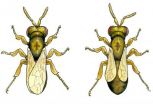(Press-News.org) Numerous mouse strains show great biological variation in features such as behavior, coat color and susceptibility to cancer and other diseases.
This study examines one possible genetic cause for differential gene expression and biological variation.
COLUMBUS, Ohio – The many short pieces of mobile DNA that exist in the genome can contribute to significant biological differences between lineages of mice, according to a new study led by researchers at the Ohio State University Comprehensive Cancer Center – Arthur G. James Cancer Hospital and Richard J. Solove Research Institute (OSUCCC – James).
The movable pieces of DNA are called transposons or "jumping genes" because they can move from one chromosomal location to another. Unlike viruses, they are not infectious and do not move from cell to cell. They have accumulated over time in the genomes of both mice and humans and now make up about half of genomic DNA in both.
For this study, researchers mapped the genomic locations of certain transposons called endogenous retroviruses (ERVs) in diverse mouse strains. They compared the different strains to learn how ERVs might influence gene expression. They found that ERVs can significantly disrupt gene expression by prematurely halting gene transcription, even when the ERV is located more than 12 thousand base pairs away in the same chromosome. They also found that the disruptive influence is affected by the gender of the parent that supplied the ERV.
The study is published online in the journal Genome Research.
"These findings add an interesting new angle to our understanding of fundamental mechanisms of natural variation and human biology, and possibly cancer and other diseases," says principal investigator Dr. David E. Symer, assistant professor of molecular virology, immunology and medical genetics and a member of the Human Cancer Genetics Program at the OSUCCC – James.
"We showed that gene expression can be influenced very strongly by a transposon located quite a distance from the premature stop site – up to many thousands of base pairs away in the genomic DNA. We also found that gene expression is influenced by whether the ERV was inherited from the father or the mother," he says.
A mouse gene containing an ERV inherited from the father often produced only an incomplete, truncated form of messenger RNA (mRNA); if the ERV came from the mother, not only the truncated transcript but also nearly normal levels of the full-length mRNA were produced from the gene.
"We believe this is an unusual, interesting example of a well-known phenomenon called DNA imprinting," Symer says. "We are now conducting experiments to understand how premature termination of gene expression can be triggered by the transposons, and also how the parent-of-origin effect occurs."
By comparing patterns of gene expression near the ERVs that were present or absent in the different strains, the researchers found about 100 genes whose expression appears to be disrupted when an ERV is present nearby.
"We observed very, very strong disruption of certain mouse genes by ERVs acting at a long genomic distance, and the resulting expression differences – up to almost 50-fold changes – can have major biological consequences that distinguish between the strains," Symer says.
INFORMATION:
END
How we move is an excellent indicator of overall health. When we feel good, we move around continually. When we're in pain, we reduce our physical activity. This observation might seem trivial, but it has led to an original approach for evaluating chronic pain. A team from EPFL's Laboratory of Movement Analysis and Measurement (LMAM) has developed a clever, easy-to-use visual tool to help doctors assess their patients' pain levels. The research appears online February 23 in the journal PLoS One.
"Movement is an objective indicator of pain. You move differently if you're ...
The tiny, little-noticed jewel wasp may provide some answers as to how different species differ in size and shape. And that could lead to a better understanding of cell growth regulation, as well as the underlying causes of some diseases.
Using the wings of these insects as a tool to study how growth is regulated, biologists at the University of Rochester have discovered that changes in expression of a well-known cell regulator gene called "unpaired" (upd) accounts for wing growth differences between males of closely related species. Unpaired is distantly related to ...
Researchers at National Jewish Health have discovered specific molecular and signaling events by which vitamin D inhibits inflammation. In their experiments, they showed that low levels of Vitamin D, comparable to levels found in millions of people, failed to inhibit the inflammatory cascade, while levels considered adequate did inhibit inflammatory signaling. They reported their results in the March 1, 2011, issue of The Journal of Immunology.
"This study goes beyond previous associations of vitamin D with various health outcomes. It outlines a clear chain of cellular ...
A major register study from the Swedish medical university Karolinska Institutet shows that children born to certain groups of immigrants in Sweden had an increased risk of developing autism with intellectual disability. The study includes all children in Stockholm County from 2001 to 2007, and brings the question of the heredity of autism to the fore.
"This is an intriguing discovery, in which we can see strong links between a certain kind of autism and the time of the mother's immigration to Sweden," says principal investigator Cecilia Magnusson, Associate Professor ...
Prof. Dr. Albert Newen and Dr. Leon de Bruin from the Institute of Philosophy II at the Ruhr-Universität explain their theory in the journal Cognition. In the first year of life, children already have a basic "theory of mind", that is, they are capable of distinguishing their own beliefs from those of others. At the age of four, this capacity is fully developed. According to the Bochum model, this development is guided by two interacting systems.
Contradictory results: "false belief" test with and without language
The test: Sally puts her ball into a basket and goes ...
Some Parkinson's Disease patients can suddenly become creative when they take dopamine therapy, producing pictures, sculptures, novels and poetry. But their new-found interests can become so overwhelming that they ignore other aspects of their everyday life, such as daily chores and social activities, according to research published in the March issue of the European Journal of Neurology.
Italian researchers studied 36 patients with Parkinson's Disease - 18 with increased artistic production and 18 without - and compared them with 36 healthy controls without Parkinson's. ...
To connect a laptop to an additional monitor, projector or even to a monitor wall, a special cable was required, until now. Researchers of the Saarland University's Intel Visual Computing Institute overcome this obstacle by linking computer and monitor via an 'Internet Service'. By this means, a screen's contents can be shifted freely to any terminal's display and even shown on large-scale monitor walls. The Saarland University's scientists present their results for the first time at stand F34, in hall 9 at the computer fair Cebit. The trade show takes place in Hannover ...
A study in Spain shows that insecurity at work is directly and negatively linked to satisfaction in work and life, as well as affecting performance and commitment. Furthermore, the research reveals that the consequences of this insecurity are different according to the occupational group they work in.
A study led by Spanish psychologists has concluded that the feeling that one is going to lose their job worsens satisfaction levels in other areas of life, such as family, health, financial circumstances and the work-free time balance.
As the fear of unemployment increases ...
Bisphenol A (BPA) is a controversial chemical widely used in the plastics industry. A new study followed people over a 10-year time period and shows that healthy people with higher urine concentrations of BPA were more likely to later develop heart disease.
The study was carried out by researchers at the Peninsula College of Medicine and Dentistry, the University of Exeter and the European Centre for the Environment and Human Health, in association with the University of Cambridge. The analysis was funded by the British Heart Foundation. The paper is published online ...
In an exclusive interview with Physics World, astronaut Drew Feustel gives a vivid account of his two missions into space and recalls his determination to make his childhood ambition – space flight – come true.
In the video, Feustel discusses his two missions – his maiden flight in 2009, as part of a team sent to repair the Hubble Space telescope, and his return to space in 2011 as the lead spacewalker on Endeavour's final mission to the International Space Station.
Recalling the first moments of launch, when you're sitting on the launch pad and the countdown hits ...


